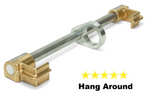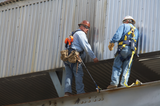Blog
I-Beam Anchorage for At-Height Workers
Recently a construction company contacted us to ask about using a
Miller Beam Anchor. They knew the anchor had the ability to provide anchorage for fall protection when used in a horizontal application. The 8816-14 from Miller is a typical beam anchor designed to provide an overhead attachment point on an I-beam or an H-beam. What they wanted to know was could they use the same product in on a vertical beam?
I'll keep the suspense to a minimum. Yes. Turns out Miller is perfectly happ
…
May 14th 2014
Keeping Your ANSI Z359 SRLs Compliant
ANSI Z359.1 was published in 1992 and approved a scant 15 years later. Slowly grind the wheels of progress. And ANSI Z359 is progress in terms of worker safety, even if it is going to cost more money in the short run. Greater regulation of worker safety almost inevitably means increased administrative work and expense for employers, compliance provides improved safety for workers and increased protection against litigation. Certainly these are both worthy goals, whether you're working in the
…
May 7th 2014
Winery Gas Monitoring: Why Your Wineries' Gas Monitors Might Not Work
Harvest in the wine country is the peak of activity in the winemaking cycle. It's Go Time - The playoffs of the wine growing season. Preparing for the avalanche of grapes means everything in the winery must be tested, sanitized, and ready. Lab equipment for checking sugar, pH, and total acidity must be made ready, barrels need to be prepped, presses cleaned, and sorting tables sorted. It's also the right time to make sure gas monitors are calibrated.
There can be many areas that require
…
Jun 27th 2013
Roofers Kit Provides At-Height Safety and Compliance
September 15th, 2012 is the date compliance with 29 federal OSHA regulations for residential builders will be required. Under 29 CFR 1926.501(b)(13) any roofer or residential builder working in an area 6 ft. or more above lower levels must be protected by conventional fall protection.
In the past, roofers were allowed to work under the 25 ft. ground to eave threshold. No longer. These federal requirements, as most professional residential workers have heard about by now, also prohibit s
…
Jul 24th 2012





